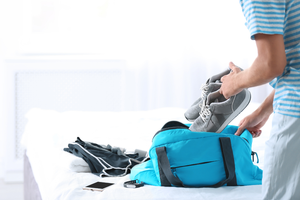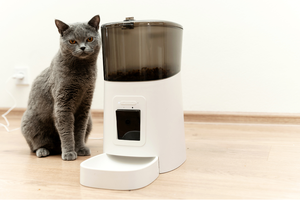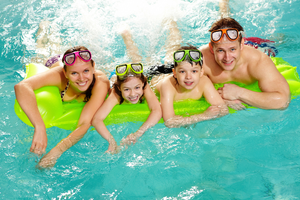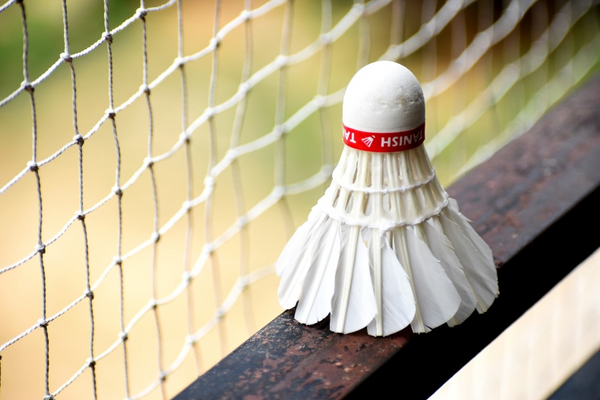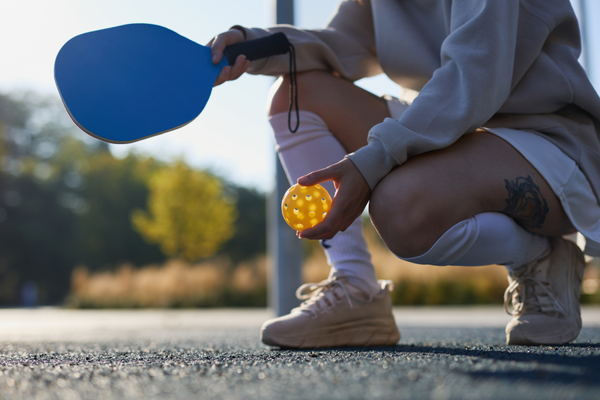Did you know that in 2020 Jeff Kolodzinski set the Guinness World Record for the most fish caught in 24 hours by reeling in a whopping 2,645 fish? Now that's some successful angling!
After hearing about that record catch you might be eager to try your hand at fishing. So let's dive into Peter Piper's ultimate guide to successful fishing on shore. Whether you’re a seasoned angler or a beginner, our guide will provide you with valuable tips, gear insights, and casting techniques to make your fishing adventure a memorable one.
Key Takeaways
- Master the shoreline and use a fish finder to maximize your chances of catching shore fish.
- Read the water, time tides, and equip yourself with the right gear for an enjoyable fishing experience.
- Respect fellow anglers’ space and follow safety measures so everyone can have a great day sporting.
Mastering the Shoreline: Essential Shore Fishing Tips
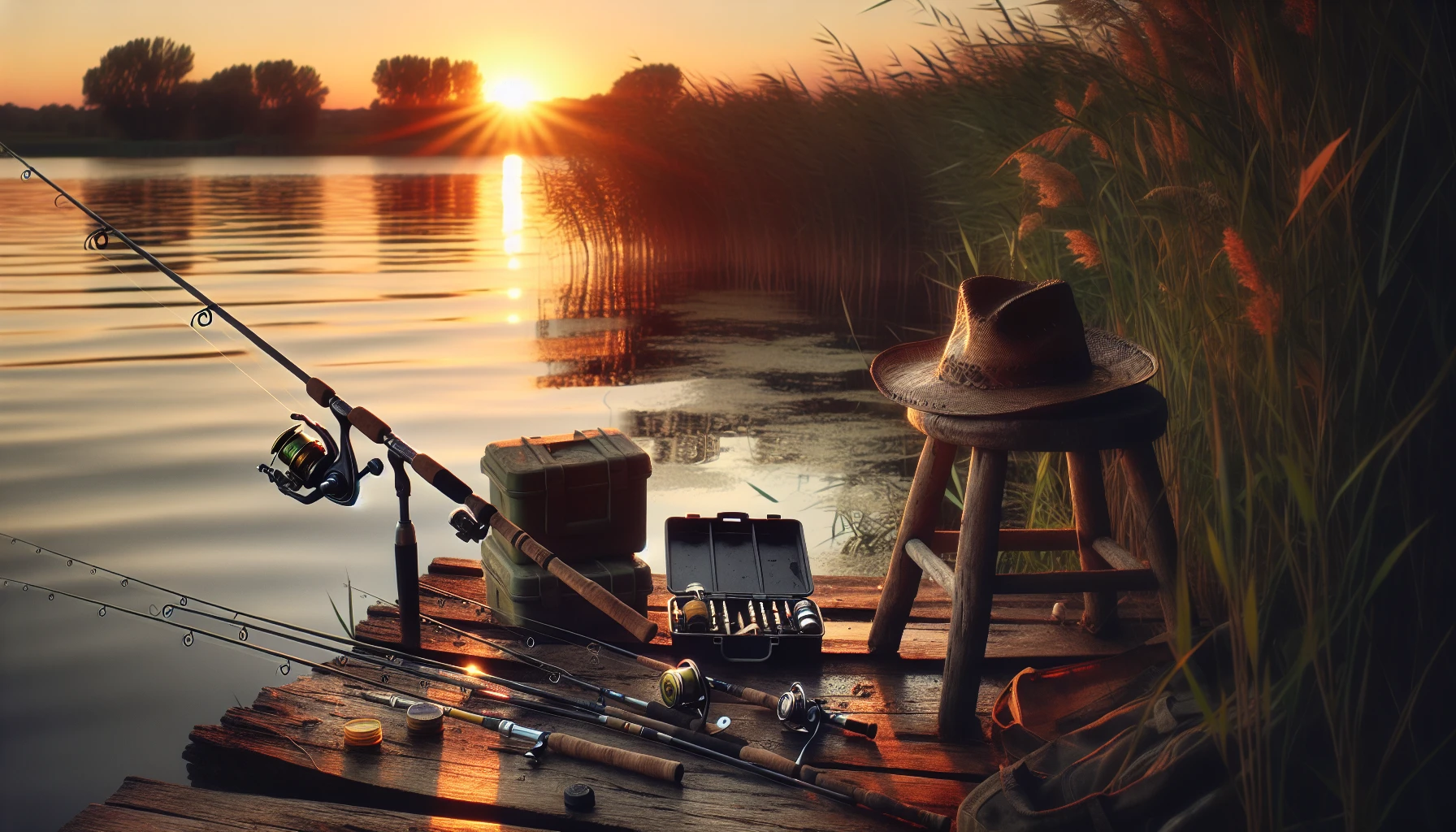
Shore fishing is an art that requires understanding the shoreline, reading the water, and timing your trip to maximize your chances of success. In addition to honing these personal skills, an angler may choose to take advanage of technology to make his or her outing more successful and exciting. A fish finder, for example, is a device that uses sound waves to help locate big fish more efficiently.
There are plenty of locations and all types of fish waiting to be caught including freshwater fish such as largemouth bass and rainbow trout, as well as saltwater catches like flounder, rockfish, and mackerel.
Read on to uncover strategies for locating the right shore fishing location and maximizing your chances of reeling in a big catch!
Choosing Your Shore Fishing Spot
While it's common for anglers to use boats or travel extensively for the ideal fishing spot, the shoreline can be equally rewarding. Shore fishing offers unique experiences and views, such as the serene beauty of a sunrise over the water and the excitement of catching fish in the shallows. Another benefit: it eliminates boat-related expenses, making it a more accessible option for many.
When you're looking for the ideal shore fishing spot, consider the following:
- Man-made structures like docks and marinas: These hotspots hold fish in great abundance. The structures structures provide shelter and breeding grounds for small fish, which in turn attract larger predatory fish, making them ideal.
- Vegetation: Fishing near vegetation can be highly effective, as these areas provide natural cover and attract various fish species. Vegetation is a rich source of food and oxygen for fish, leading to higher fish activity and better chances for a catch.
- Hiding spots: Target areas with fallen trees, stumps, or rocky outcroppings, as these are often havens for fish.
- Natural features such as sand bars: Sand bars and other shallow natural formations are magnets for fish, offering excellent opportunities for successful catches. These areas often house smaller fish and crustaceans, which attract larger predatory fish.
The key is to be observant and explore different areas. Note where the fish can be found depending on the time of day, weather conditions, and food availability.
Reading the Water: Identifying Productive Areas
To catch more fish, it’s essential to read the water and identify productive areas to cast your line. In streams, creeks, and rivers, look for deeper pockets, current ambush points, and natural and man-made current breaks. Spillways are narrow passages that divert water from large water bodies and increase the water's oxygenation and cooling. This creates an environment that attracts baitfish and bigger fish like salmon and trout.
Keep an eye out for shady areas, especially at dawn and dusk, when fish are most active. Water temperature influences fish behavior in different seasons, so understanding the preferred temperature ranges of different fish species can greatly help you locate and catch them more effectively. For instance, trout prefer cooler waters between 50-60°F, while bass thrive in warmer temperatures around 65-80°F. Maintain keen observation of the water to enhance your catch success rate.
Timing Your Trip: High Tide vs Low Tide
Weather and tides significantly influence your shore fishing success. Understanding when fish are likely to bite is extremely beneficial. High tide is generally considered superior for fishing. During this time, fish are more active and tend to venture closer to the shore, making them easier to catch. Conversely, low tide can make fishing more challenging as the water recedes and fish may retreat to deeper areas.
Nevertheless, the prime moments for fishing occur during the shifts between high and low tides, specifically when the water is in motion. The transition from high tide to low tide, or vice versa, typically triggers heightened fish activity. However, when the water approaches the peaks of high tide or low tide, it decelerates and reaches a standstill, entering a "slack" phase, during which fish are less inclined to bite.
Among various tide phases, a rising tide, also known as an incoming tide, is frequently regarded as optimal for fishing. During this period, the water flowing into an estuary from the ocean tends to be cooler, richer in oxygen, and clearer compared to the water in the estuary during low tide or slack water intervals. This results in a more advantageous habitat for fish, enhancing the likelihood of a successful fishing experience.
Tackling the Essentials: Gear Up for Shore Fishing
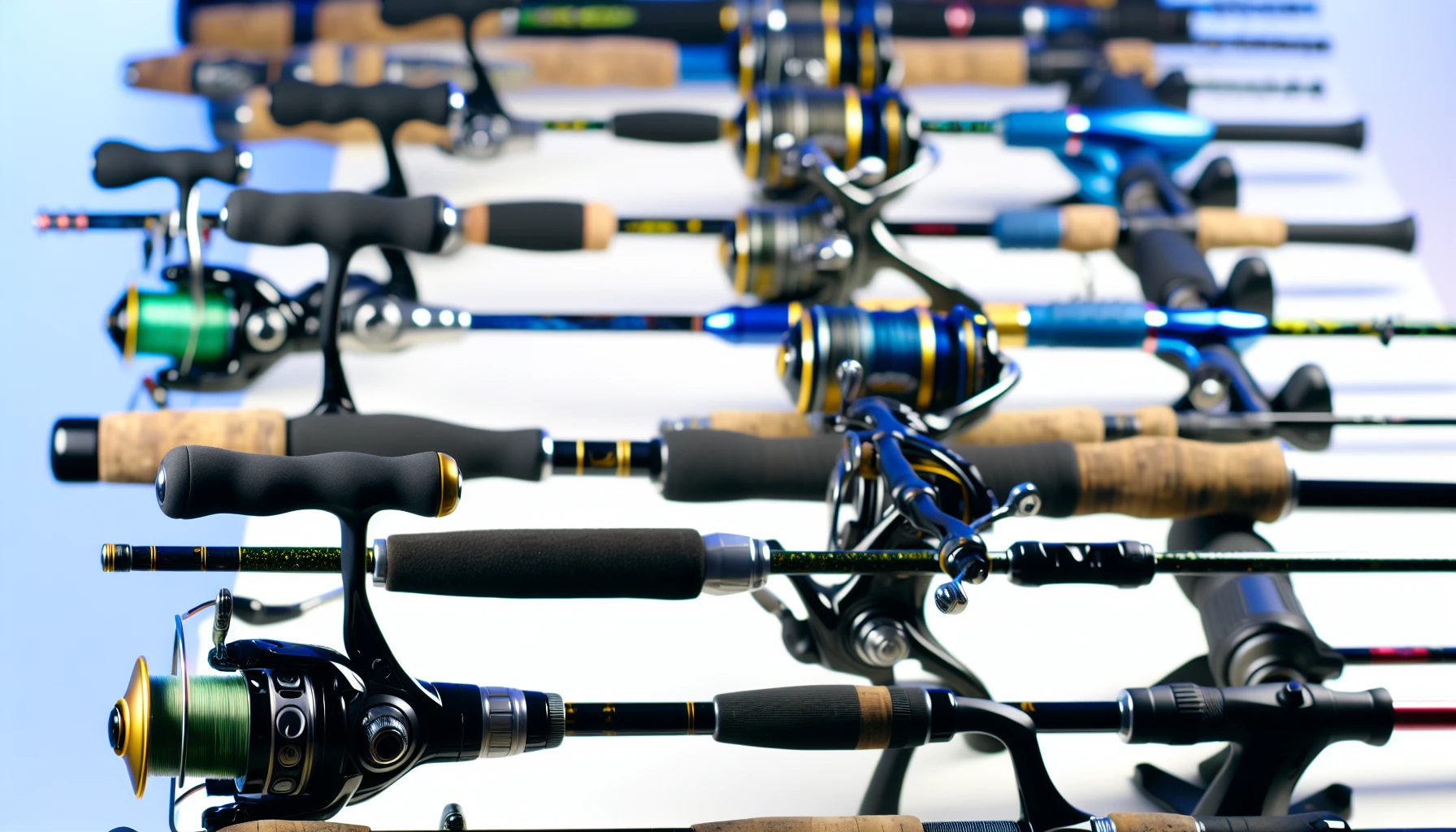
From rods and reels to tackle and bait, having the proper equipment at your disposal can make all the difference in your adventure. Let's examine the essentials (along with a few other things you might not have considered) to ensure you're well-prepared for a great day of fishing.
Rods and Reels: The Shore Angler's Arsenal
Let's take a closer look at key types of rods that every shore angler should know about. Each of these designs has unique features and benefits tailored to different aspects of shore fishing. Whether you're targeting small freshwater species or casting into the surf for larger catches, understanding the nuances of these rods will greatly enhance your fishing experience.
- Float Fishing Kits: These kits are designed for float fishing, a technique where a float (or bobber) suspends the bait at a predetermined depth in the water. The float signals a bite when it moves or dips. Float fishing kits typically include a rod, reel, line, and various floats, weights, and hooks. They are versatile and can be used in both fresh and saltwater environments, ideal for targeting a range of species from small panfish to larger predatory fish.
- 7-9ft Spinning Rods: These are medium-length rods, ideal for spinning, a popular method of fishing that involves casting a lure and retrieving it in a way that makes it move in the water, attracting fish. The 7-9ft length offers a good balance of casting distance and accuracy, making these rods suitable for a variety of fishing environments, from riverbanks to lakes. They're versatile enough to handle a range of fish sizes.
- Large Beach Caster Rods with Multiplier Reels: Beach caster rods, often longer than typical spinning rods (usually over 12 feet) are designed for casting long distances from the shore, particularly in sea fishing. They are paired with multiplier reels, which offer greater control and accuracy in casting. This combination is ideal for surf fishing, where anglers need to cast their lines far out into the sea to reach fish. These rods are robust and can handle large baits and big fish.
- Telescopic Rods for Feathering and Spinning: Telescopic rods are collapsible, making them highly portable and easy to store. They are versatile and can be used for various fishing techniques, including feathering (a technique where multiple hooks with feathers are used to mimic a school of small fish, attracting larger predators) and spinning. These rods are convenient for anglers who travel or have limited space, and they come in various lengths and strengths to suit different fishing conditions.
Remember that any accessory, including the rod and reel, will have its unique pros and cons. You'll also want to ensure that your set aligns with your style and personal requirements. A little time spent researching these choices online will pay off at the shore!
Some products worth your consideration include:
- Daiwa BG Surf Spinning Combo
- Penn Spinfisher VI Combo
- Penn Battle III Spinning Combo
- Ugly Stik Bigwater Surf Combo
- Shimano Tiralejo XX TRJXS96M
These rods and reels are designed to fit a variety of fishing situations, from casting long distances to handling both small and powerful fish.
The Ultimate Tackle Box Checklist
A well-stocked tackle box is like an angler’s treasure chest, filled with essential items that can make or break a fishing trip. To ensure a successful shore fishing experience, you should consider including the following items:
- Owner Twistlock Hooks: These hooks have a unique twistlock feature for secure lure attachment, ideal for soft plastic baits.
- Trout Eye Jigheads: Specifically designed for trout fishing, these jigheads feature prominent eyes and a balanced design for effective lure presentation.
- Redfish Eye Jigheads: Tailored for redfish, these jigheads have large, eye-catching eyes and are built to withstand tough battles.
- Rod: The primary tool for casting and retrieving, available in various lengths and strengths to suit different fishing styles and species.
- Reel: A device attached to the rod for winding and stowing line, crucial for controlling the line during casting and landing a fish.
- Line: The fishing line is the medium that connects the reel to the hook, varying in strength and type for different fishing conditions.
- Leader: A short section of line, usually more robust or less visible, tied between the main line and the hook or lure.
- Swivels: Small devices that connect the line to the leader or lure, preventing line twisting and tangling.
- Lures: Artificial fishing baits designed to attract fish, available in a wide range of shapes, colors, and styles to mimic various prey.
- Bait rig: A setup of hooks and weights designed for bait fishing, allowing for multiple bait presentations simultaneously.
- Pliers: A multi-functional tool used for removing hooks, cutting line, and other tasks requiring fine manipulation.
- Gloves: Protective gear for hands, useful for handling fish, bait, and sharp equipment.
- Knives: Essential for cutting bait, filleting fish, or other cutting tasks during fishing.
- Cutting Board: A flat surface for cutting bait or filleting fish, keeping tools and fish clean.
- Bucket: Useful for carrying bait, fish, or tools, and sometimes for mixing ground bait.
- Waders: Waterproof boots or pants that allow anglers to enter the water comfortably and safely.
- Extra line: Spare fishing line to replace or replenish the line on the reel as needed.
- Bobbers: Floats that suspend bait at a predetermined depth and indicate when a fish bites.
- Weights: Small weights used to sink the bait or lure to the desired depth.
- Knife/Scissors: Tools for cutting line, bait, or other materials, essential for rigging and bait preparation.
- Spare hooks: Extra hooks to replace damaged ones or to change hook sizes and styles as needed.
Note that the usefulness of a well-stocked tackle box hinges on the angler utilizing it. Be sure to invest time in learning how to properly use each piece of equipment.
Fishing Tackle Bags
If you prefer a more mobile and convenient option than a traditional tackle box, fishing tackle bags might be the perfect choice for you. Fishing tackle bags come in two main types: surf fishing bags and fishing backpacks with rod holders. When selecting a suitable fishing tackle bag for shore fishing, make sure to take into account factors like waterproofing, storage capacity, durability, comfort, and quality. Top-rated brands for surf fishing bags include Blisswill, Yvleen, and KastKing.
Fishing backpacks with rod holders offer added convenience, allowing you to easily carry and access your gear while on the move. If you're interested in learning more about selecting the perfect tackle bag for your shore fishing adventures, we invite you to read our detailed article on the topic. You can find it here: Best Surf Fishing Bag for Your Angling Needs.
Bait Selection: Live vs Artificial
In the world of fishing, one of the most debated topics is the choice between live bait and artificial lures. Each method has its own set of advantages and hard-core enthusiasts.
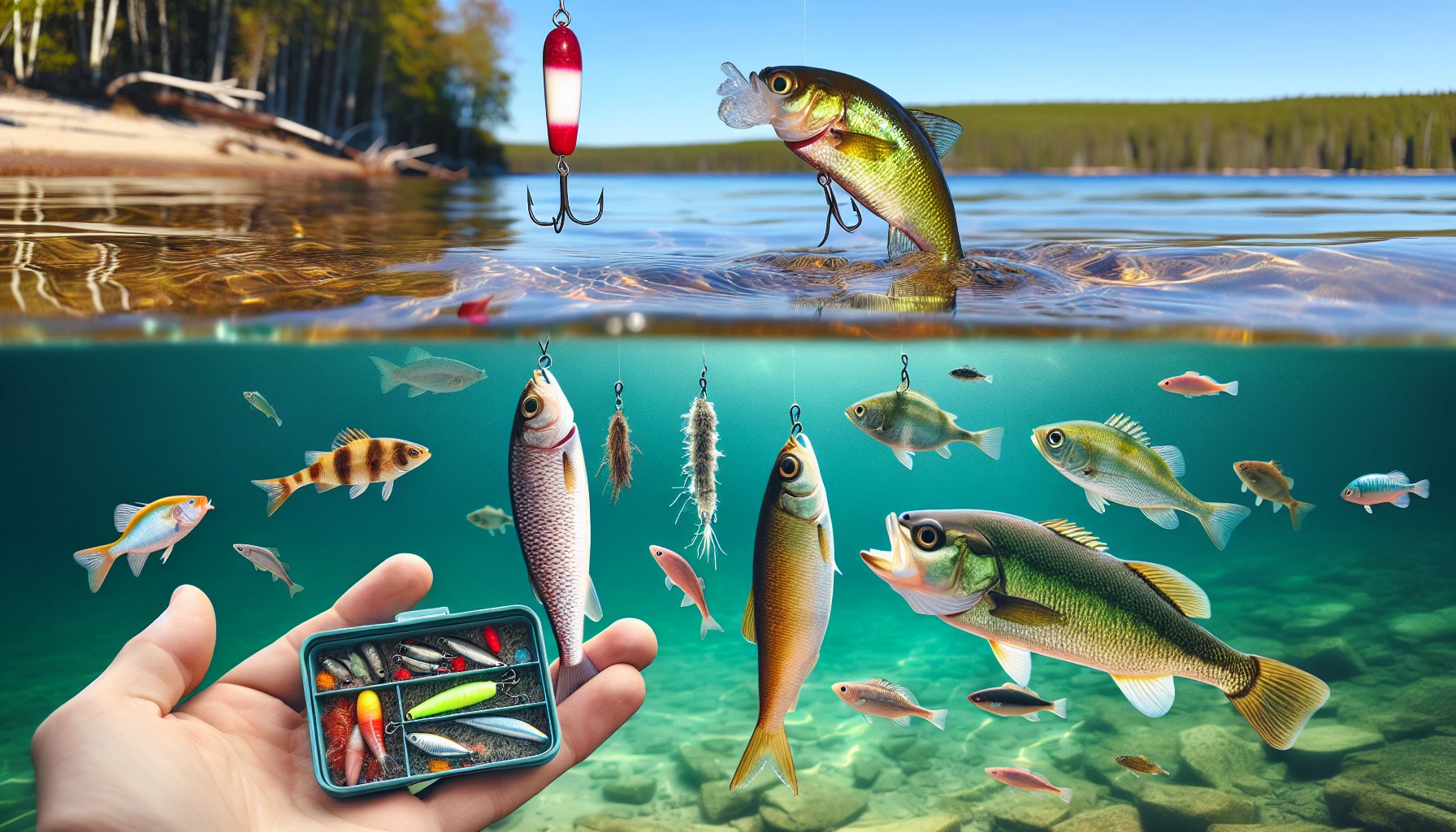
Live Bait:
- Natural appeal: Live bait, such as bait fish, has a natural scent and movement that can attract fish effectively. Cut bait and live shrimp are great baits for shore fishing - try squid, mullet, ballyhoo, pilchards, or sand fleas for a variety of saltwater game fish.
- Cost-effectiveness: Live bait can be more cost-friendly and readily available in certain areas.
- Handling and storage: Live bait requires careful handling and proper storage to maintain its freshness and effectiveness.
Artificial Lures:
- Versatility: Artificial lures come in a wide array of shapes, sizes, and colors, providing greater flexibility in targeting different fish species.
- Durability: Unlike live bait, artificial lures are more durable and can withstand repeated use.
- Investment: Although they may cost more upfront, artificial lures can be a sound investment in the long run for regular shore anglers.
In the end, the decision between live bait and artificial lures is a matter of personal preference and specific fishing conditions.
Casting Techniques for Shore Anglers
Mastering casting techniques is a vital skill for shore anglers looking to land more fish. The three main casting techniques for shore anglers are overhead, underhand, and parallel casting, each offering unique advantages in different fishing scenarios. Join us as we look at these techniques.
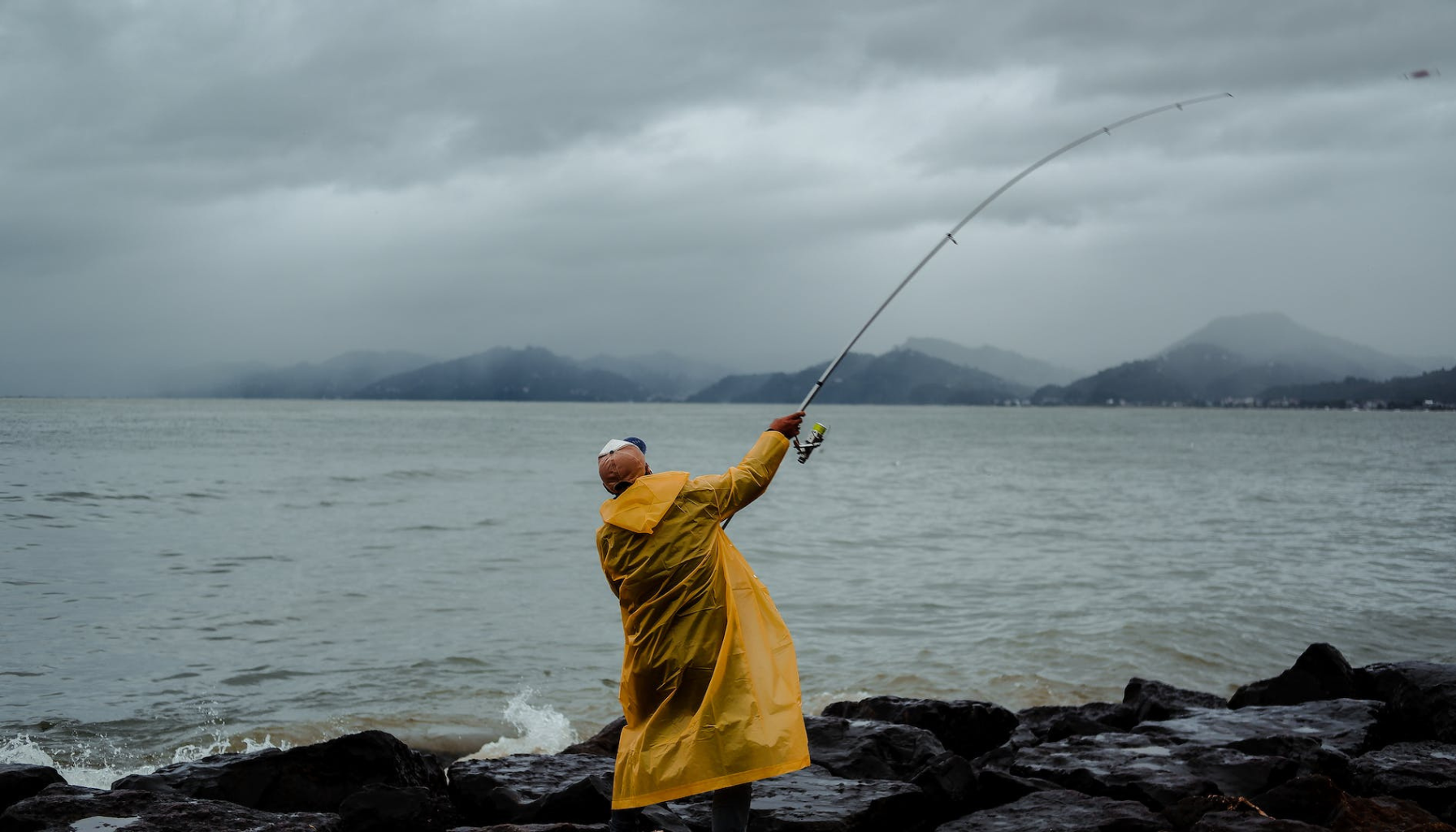
Master the Overhead Cast
The overhead cast is one of the most fundamental techniques in shore fishing. To execute an overhead cast, follow these steps:
- Stand with assurance, firmly holding the rod with four fingers encircling the handle, thumb positioned on top, and the reel facing downward.
- Flick the rod tip smoothly without jerking the rod.
- Extend your arm fully during the cast while pointing the rod toward your target.
For better accuracy and distance maximization, follow these tips for an overhead cast:
- Leave roughly 6 inches of line at the end of your cast rather than winding the lure entirely to the rod tip.
- Restrain the rod’s overhead side-to-side movement.
- Steer clear from overloading your reel’s spool.
With practice and refinement of technique, you can achieve maximum distance and accuracy with an overhead cast.
The Art of the Underhand Cast
The underhand cast, invented by Swedish fly-fishing expert Goran Andersson, is a revolutionary way of using a D-loop method as a roll cast. The D loop is a casting method in fishing where the line forms a 'D' shape in the air during the backcast, providing the necessary line speed and direction for the forward cast. This technique offers the following advantages:
- Gentle and accurate landing of your bait or lure
- Better control than using the D loop method
- Improved casting distance and accuracy with modern spinning reels
To execute an underhand cast, follow these steps:
- Find a high position to stand on.
- Hold the fishing rod with both hands below the reel.
- Whip the tip of the rod while pushing with one hand and pulling with the other.
- Practice and refine your wrist movement and rod tip control to achieve accuracy and distance with your underhand cast.
Bear in mind that proficiency in the underhand cast technique is achievable through consistent practice and persistence.
Casting Parallel to Shorelines
Parallel casting is a technique where anglers cast their lines along the shoreline or depth lines, rather than towards them. This approach is highly effective in spring for catching bass, as it keeps the lure in the strike zone longer, thus enhancing catch chances. Adaptable to various waters, it's ideal for different fishing conditions.
To effectively cast parallel to the shoreline, follow these steps:
- Determine the depth where the majority of bites are coming from.
- Cast parallel to the shoreline to maximize your bait’s time in the strike zone.
- Avoid casting perpendicular to the shoreline, as it may not be as effective in keeping your bait in the strike zone.
Casting parallel to the shoreline while bank fishing can help you to catch bass among other fish species.
Mobility Matters: Stay Light on Your Feet
Mobility is a key factor in successful shore fishing, allowing you to explore different spots and locate the most productive fishing areas. In the context of shore fishing, mobility refers to the ability to move freely and efficiently along the shoreline, enabling you to explore various fishing spots and maximize your fishing experience. Packing light and moving efficiently can significantly enhance your fishing experience, enabling you to cover more ground and make the most of your time on the water.
Pack Smart, Move More
In terms of packing for a shore fishing trip, minimalism usually proves beneficial. By packing light and bringing only the essential items, you can move swiftly and comfortably along the shore, discovering different fishing spots and covering a larger area. Some great lightweight gear options for shore fishing include:
- A lightweight rod
- A lightweight reel
- Lightweight fishing line
- A tackle bag or box to carry your lures and accessories
Wading In: When to Get Your Feet Wet
Wading can be a game-changer in shore fishing as it may offer better positioning and casting placement. It allows you to access deeper areas or navigate through flowing water in streams, rivers, and coastal waters. The ideal depth for wading depends on the speed of the current, with slow currents allowing for chest-deep wading and faster currents best tackled in knee-deep water.
Gear for wading includes:
- Wade Fishing Belt: A belt designed for stability and safety in the water, often featuring attachments for tools and gear.
- Landing Gear: Equipment used for safely landing and handling fish, like nets and grips.
- Fishing Line Cutters: Compact, efficient tools for quickly and cleanly cutting fishing lines.
- Wading Boots: Specialized boots provide traction and foot protection in slippery and uneven underwater terrain.
- Stringer: A line or chain for holding caught fish in the water, keeping them fresh until you're done fishing.
Shore Fishing Etiquette and Safety
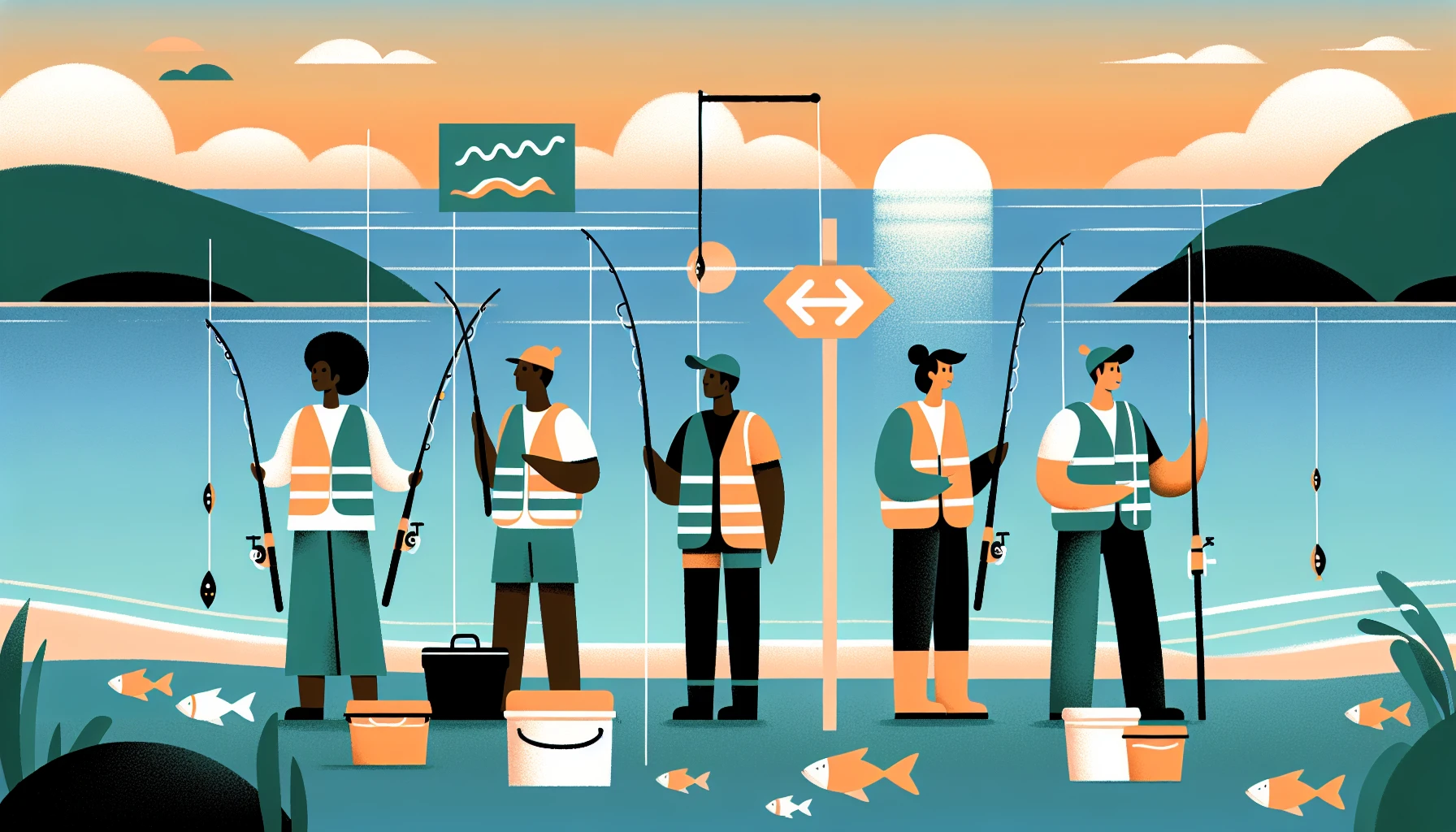
Practicing proper shore fishing etiquette and safety is essential for ensuring an enjoyable experience for all anglers. By respecting the space of fellow anglers, preparing for the unexpected, and emphasizing safety, you can create a positive and memorable fishing environment for everyone involved.
Respect the Space of Fellow Anglers
Keeping an adequate distance from other anglers is vital for a peaceful fishing experience. Respecting each other’s space ensures that everyone can fish comfortably and avoids potential conflicts or issues. When shore fishing in crowded areas, practice good etiquette by leaving at least 50 feet of space between you and other anglers, avoiding fishing near swimmers or popular swimming areas, and disposing of used soft plastics properly.
Safety First: Preparing for the Unexpected
Safety ought to be prioritized in shore fishing. Preparing for unexpected situations such as weather changes, injuries, or equipment malfunctions can help ensure a safe and enjoyable time on the water. Consider equipping yourself with essential safety gear such as:
- A personal flotation device
- Sun protection
- Weather-appropriate clothing
- First aid kit
Be proactive in identifying potential hazards and stay alert to your surroundings. This includes being aware of:
- Wildlife
- Poisonous plants
- Dangerous water conditions
- Slippery rocks
Summary
Shore fishing offers a unique and rewarding experience for anglers of all levels. By mastering the shoreline, gearing up with essential equipment, perfecting casting techniques, staying mobile and light on your feet, and practicing proper etiquette and safety, you will enjoy a successful and memorable fishing adventure. So go ahead, grab your gear, and explore the exciting world of shore fishing!


